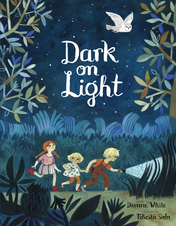 Review by Megan Litwin DARK ON LIGHT by Dianne White and illustrated by Felicita Sala (Beach Lane Books, 2022) is everything that makes the picture book such a unique and nourishing book form. Precise language that both surprises and delights? Check. Beautiful art that also adds an important visual layer? Check. Perfect rhythm and pacing that make the entire reading experience an irresistible journey? Check. From the very first pages, the reader is pulled in with White’s gentle, poetic voice. “Gentle the evening. Sweeping the skies. Dark the shadows as twilight arrives. Rose the horizon, gleaming and bright. Twilight and evening and dark on light.” As we watch a trio of children head out at dusk to search for their lost pup (frolicking and investigating nighttime wonders along the way), that phrasing continues in an inviting and tantalizing way. The pages practically turn themselves, it all feels so magical and other-worldly. By the end, when everyone is back home and all is well, the reader feels tucked into that snug, dark attic too, ready to sleep beneath that glowing moon. “Quiet the room. Soothing the chime. Dark the house that waits in time.” Don’t wait to check out this dreamy book! On Writing: If you lean toward the lyrical, as I often do myself, DARK ON LIGHT is a phenomenal mentor text (along with this author-illustrator team’s previous book, GREEN ON GREEN). On the first read, you’ll be pulled in by the mesmerizing language. Lean in and enjoy it. But on that second or third (or fourth) reading, notice how it is done. Notice the care White took with choosing her words, the unexpected way she structured them, and which ones she purposefully chose to repeat. There is nothing done by chance here. This is an example of a poet doing what poets do – finding the exact right words, and then finding the right way to string them together. Not easy work, of course, but seeing the effect of this work done well should be an inspiration for us all to keep at it! To learn more about author Dianne White visit https://diannewrites.com/ or find her on social media @diannewrites.
To learn more about illustrator Felicita Sala visit https://www.felicitasala.com/. Click here to purchase Dark on Light.
0 Comments
 Reviewed by Amanda Smith In A Work in Progress (Aladdin, May 2023), Jarrett Lerner introduces the reader to Will Chambers, a middle school boy who struggles with self-acceptance and negative body-image. A cruel classmate’s ruthless words, slung at Will back in fourth grade, were “tattooed on [his] brain” and set Will on a path of self-loathing and social withdrawal. He slinks in hallways, hides in oversized clothes, and becomes his “own bully” doing “the job better than anyone else possibly could.” Written as Will’s personal notebook, this groundbreaking illustrated novel-in verse takes the reader deep into Will’s emotional pain and physical battle with eating disorders. The fact that this seldom told story, about body dysmorphia in boys, is presented in a format appealing to its intended audience makes this book a trailblazer. Sparse text, emotion-laden doodles, and swaths of negative space on the pages make this an accessible, though not light, choice for young readers. However, even children who do not combat negative body-image will find themselves somewhere in the pages of this highly relatable novel that addresses among other teen-tensions, the feeling of not being enough, changing friendships, hiding-in-plain-sight, anger, and shame. Like Will, every teen yearns to be truly seen, to be understood, and to have confidence. Along with Will, all young readers can discover that it is okay to be A Work in Progress. On Writing: In his guest blog, Jarrett digs into the challenges keeping writing tight while creating a novel that looks like a fun notebook, with squiggles and doodles, exclamation points and creative typography. (You can find the blog here.) A Work in Progress shines as a mentor text for diction. Although this book is a departure from Jarret Lerner’s usual humorous style, his language use still honors the age of the narrator, despite the heaviness of the topic. For example, about the inciting incident, Will uses the following metaphor: “You’ve stepped through a door and now the thing is locked behind you. Or no: it’s crazier. You step through a door and then the door disappears.” Jarrett’s word-choice for the things Will notices, in his internal rants, and even in the figures of speech Will uses, emulates the way Lerner’s readers experience and talk about their world. Read your writing out loud. Do your word-choice and phrasing reflect your readers’ world? Visit Jarrett’s website to learn more about his story and books. 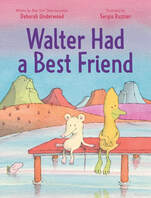 Review by Kristi Mahoney Walter Had a Best Friend (Beach Lane Books, October 2022), by author Deborah Underwood and illustrator Sergio Ruzzier is a story of friendship that sometimes drifts apart. Walter and Xavier are best friends who do everything together. Until slowly, quietly, they’re not. As Xavier spends more time with new friend Penelope, Walter is left with a big hole in his heart where Xavier used to be. It’s not until a sunny day beckons Walter to get up and back out into the world, that he finds just the thing to make his heart full again. Ruzzier’s scenes set in soft pastels perfectly complement the story, capturing the weight of moments where emotions are heavy but words are purposely spare. Walter Had a Best Friend is an important SEL book showing that friendship can change and sometimes end. But slowly, quietly…it will be okay. On Writing: There are a number of ways we can use Underwood’s techniques as a mentor text for our own writing. To truly capture the power of this story, Underwood demonstrates extremely effective pacing. Using a restraint with words, the author opts for sparse, well-chosen text as well as a few repetitive words/phrases that are packed with emotion to make a big impact. Her pacing encourages the reader to slow down and process the story as it unfolds: the fading friendship, the aftermath, and ultimately…the hope that lies ahead. Underwood’s sparse text is a reminder of the power that can be infused into picture books if authors leave room for the illustrator. Within this book, there are spreads that only feature one or two words. But these words combined with the emotional art carry more weight than a whole paragraph of explanation. Although this story is packed with heart, it’s a different kind that’s not prevalent in picture books —at times more raw and relatable than warm and fuzzy. Yet it ends with the important nugget every picture book needs —a ray of hope. There is a saying that you don’t always remember what someone says, but you’ll always remember how they made you feel. Long after reading Walter Had a Best Friend, I remember the feeling it evoked. I remember —the heart. Isn’t that what we all strive for as writers? To learn more about author Deborah Underwood visit https://www.deborahunderwoodbooks.com/
or find her on social media @UnderwoodWriter. To learn more about illustrator Sergio Ruzzier visit http://www.ruzzier.com/. Click here to purchase Walter Had a Best Friend. 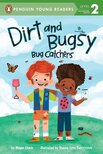 ~Reviewed by Amanda Smith Dirt and Bugsy are friends and bug catchers. They dig, lift, and sift to find all kinds of creepies and crawlies, but when it starts to rain, Dirt and Bugsy are concerned for their new bug friends. They come up with a marvelous plan to keep the bugs dry. Dirt and Bugsy: Bug Catchers by Megan Litwin, illustrated by Shuana Lynn Panczyszyn (Penguin Young Readers, February 2023) is an entertaining Level 2 book for progressing readers. Its conversational tone, action packed pages, and engaging story-line will get new readers’ brains buzzing. The bright color palette, detailed bug illustrations, and kids’ joyful expressions add to a fun reading experience that will ignite a love for bugs and books (and more bug-books!)! And the bug-catcher tips in the back are sure to lure readers outside for their own arthropod adventures.  Lower elementary teachers will want to snatch up Dirt and Bugsy: Bug Catchers for their classrooms, and keep their nets at hand for Dirt and Bugsy: Beetle Mania that will hatch in June! On Writing: Megan’s experience as a former teacher and reading specialist is evident on every page of Bug Catchers. If your work-in-progress is an early reader, study Bug Catchers for rhyming refrains with similar sounds that make decoding easy and familiar for young readers. Megan employs the repetition of words and sounds in close proximity, as well as alliteration and assonance in the text, making this fun adventure accessible, even to reluctant readers. The text swarms with playfulness, humor, and a fun pun at the end. Megan certainly knows how to capture young readers “again, and again, and again…” and a close study of her work can help bring the same success to your manuscript. To learn more about Megan Litwin, her books, events and workshops, visit https://www.meganlitwinbooks.com/about. You can see more of Shauna Lynn’s cheerful art here: https://shaunalynn.com/ 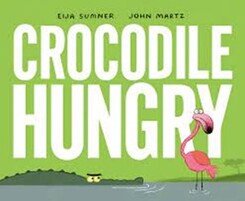 Review by Kristi Mahoney You don’t have to look further than the title to see the problem in this hilarious story, Crocodile Hungry (Tundra, 2022) written by debut author Eija Sumner and illustrated by John Martz. Main character, Crocodile, is hungry and sets out to find something to eat, visiting various places such as the farmer’s market, grocery store, and even the community garden. Unfortunately, Crocodile’s efforts turn out to be fruitless and he quickly goes from hungry to hangry. It’s not until the prefect solution lands right in front of Crocodile that he finally knows exactly what to eat. Martz’s art is the perfect complement to Sumner’s words, adding layers of humor and hilarious details that may just make Crocodile Hungry your next favorite read aloud. On Writing: I brought Crocodile Hungry to one of our 24 Carrot Writing meetings where, amongst other things, we discuss picture books from a writer’s perspective. It was an instant crowd pleaser. Yes, it contains a lot of elements that denotes good writing: A clear goal? Check. Satisfying page turns? Check. Humor and Heart? This one is a hard one to pull off, especially in a book that’s streamlined at around 150 words. But check, check. Yet there were two additional things that made Crocodile Hungry go from fun to fantastic: voice and the unexpected. The voice Eija Sumner chose for the main character is not only unique and kid friendly but endearing and delightfully witty. There’s something to be said for writing in a way that leads or directs the reader how to read (or perform) the book. The voice more than begs to be read aloud- it instructs how to read Crocodile’s voice. And that makes this a fantastic mentor text for writers as well as a hilarious read-aloud. The unexpected nature of this story is one of the main reasons it’s so successful. We might expect that if a crocodile is hungry, he’d go hunting in his natural habitat. But, instead, Sumner takes us to very un-crocodile-like places that happen to be very kid friendly and relatable. But Sumner doesn’t stop there. The unexpected continues to unfold with every page turn until the very last laugh. I don’t want to give anything away, but let’s just say that in terms of smart writing and a satisfying ending, Sumner serves up a banquet of delight. Crocodile Hungry will leave readers guessing with every page turn and giggling (big crocodile tears) until the very last page. To learn more about author Eija Sumner visit https://eijasumner.com/ or find her on social media @eijas.
To learn more about illustrator John Martz visit https://johnmartz.com/ or find him on social media @johnmartz. Click here to purchase Crocodile Hungry.  Throughout 2022, 24 Carrot Writing has shared our favorite books in our Book Picks section. As the holiday season approaches, these books would make perfect gifts for readers and writers alike. Enjoy a round-up of 24 Carrot Writing's 2022 Books Picks. As a bonus, we've asked a few of our Book Pick authors to recommend one of their favorite 2022 books too! Put these books on your want to read list, your mentor lists, and then wrap them up and share them just in time for reading during the winter season. Megan Litwin's Book Pick 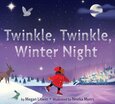 In TWINKLE, TWINKLE, WINTER NIGHT (September 20, 2022, Clarion Books), debut author Megan Litwin and illustrator Nneka Myers take readers on an exquisite journey through a magnificent winter wonderland. This beautiful book is about finding joy in the details, seeing light in the darkness, and discovering all of the many wonders of the season. Read the full Book Pick here. 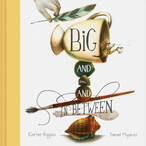 BIG AND SMALL AND IN-BETWEEN (Chronicle, 2022) written by Carter Higgins and illustrated by Daniel Miyares, is a uniquely stunning picture book in which a carefully arranged list unfolds across three sections, categorized by size. The list of “things” is not just things at all, but rather a range of observations, experiences, emotions, and more - all presented in glorious, linger-worthy detail. Writers could learn a lot from the specificity of this book, and the way it taps right into the heart of childhood. As a teacher, I used to do a lot of work helping young writers “zoom in” on the world and their personal experiences – and that is exactly what this book does, making it a mentor text for writers of all sizes. Marcy Campbell's Book Pick 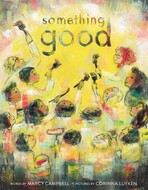 The first page of SOMETHING GOOD (LBYR, 2021) written by Marcy Campbell, illustrated by Corinna Luyken, starts like this: “The day the custodian found the bad-something on the bathroom wall…”. With those words, Campbell drops us right into this beautiful, powerful story – and into the tangle of feelings and questions that circle through an entire school community. Read the full Book Pick here. 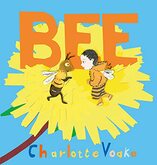 In Charlotte Voake's BEE, a curious boy gets a glimpse into the lives of bees when he is magically transformed into one for a day. This book so perfectly captures a child’s imagination, while also managing to incorporate science facts and ends with an easy way to show love and appreciation for these amazing creatures. Sometimes, as writers, we can over explain. In this fictional story, which nonetheless helps kids learn information about bees, we never lose the thread of the young narrator’s point of view and his sense of wonder. Blanca Gomez's Book Pick 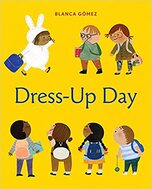 In DRESS-UP DAY, by author/illustrator Blanca Gomez a young girl is distressed to have missed her opportunity to dress up as a bunny for her class' dress-up day because she's out sick. She decides to wear her bunny outfit to school the next day (What could go wrong?). With smart, sparse text and evocative illustrations that make the characters' emotions dance off the page, Gómez conveys a message of acceptance and kindness without once stating or summarizing the theme of her story. Read the full Book Pick here. 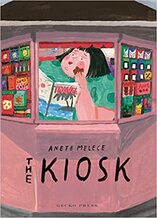 THE KIOSK by Anete Melece is about Olga, who works and lives in her kiosk, where she finds herself stuck. Until one day something happens… I love this book because it reminds me of the books I used to read when I was a kid; or at least it made me feel the same way. Books about normal people living incredible situations, a bit surreal and totally crazy. The book is a great example of how to tell a story. We can see Olga is literally stuck: her body cannot physically escape from the kiosk, but the first lines of the book: “Olga has been living and working at the kiosk for a long, long time. Maybe too long” are telling us that Olga is also mentally trapped. She dreams about travelling, about doing something else… but she needs a push, and we certainly can see that push along the pages of the book. THE KIOSK is a great example of how to talk about important matters in a really funny and unexpected way. April Jones Prince's Book Pick 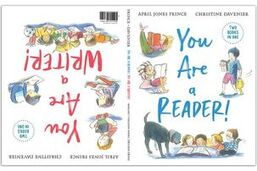 YOU ARE A READER! YOU ARE A WRITER! by April Jones Prince and illustrated by Christine Davenier (Margaret Ferguson Books, 2021) is a book for readers and writers everywhere. Its “two-books-in-one” design cleverly shows that readers are writers and writers are readers, and the acts of reading and writing are all around. Writers of all ages would do well to read Prince’s pages on being a writer. To begin, she notes the importance of looking and listening well, no matter what you’re doing. Read the full Book Pick here. 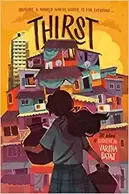 In THIRST by Varsha Bajaj, communal water taps in Minni's impoverished Mumbai neighborhood provide water only a few hours a day. This compelling middle grade novel is an important reminder that things we often take for granted are not equally accessible in other parts of the world and that speaking up is something we all have the power to do. I loved Minni’s grit and compassion and especially the deep and broad community that sustains her throughout the story. As a mentor text, THIRST is a master class in creating a cast of primary and secondary characters who feel real, relatable, and true and in leaving readers feeling empowered and fulfilled. (After reading you’ll be thirsty for more Varsha Bajaj, so check out her inclusive middle grade novel COUNT ME IN as well!) 24 Carrot Writing's 2022 Book Picks  In JOHN'S TURN, it's a young boy's turn to demonstrate his talent during the school's "Sharing Gifts" time. Mac Barnett's simple yet strong text - along with expressive illustrations by Kate Berube - gives the reader the space to experience the emotional power of the story without once pointing out the message. Read the full Book Pick here.  THE CREATURE OF HABIT (Random House Studio, 2021), by Jennifer E. Smith and illustrated by Leo Espinosa, tells the story of an island dwelling creature who loves his routine. A great mentor text to examine the way long vs short, and serious vs silly sentences can move plot, create tension, drive pacing, and enhance readability. Read the full Book Pick here. 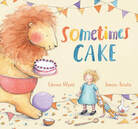 You may think balloons and cake are just for birthdays, but SOMETIMES CAKE (Candlewick, January 2022), written by Edwina Wyatt and illustrated by Tamsin Ainslie, proves that when it comes to celebrations, thinking out-of-the-box is encouraged. SOMETIMES CAKE combines two lovable characters, kid-friendly dialogue, and perfectly pared-down prose. Read the full Book Pick here. 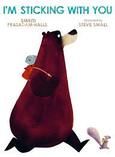 In I'M STICKING WITH YOU, (Henry Holt and Company, 2020), written by Smriti Prasadam-Halls and illustrated by Steve Small, Bear vows to be there for and do everything with his best friend, Squirrel. But when Bear’s enthusiastic devotion wreaks havoc on his buddy’s things and space, Squirrel decides their friendship may becoming a little… over-bearing. A perfect mentor text for first person rhyme and dual narrator transitions. Read the full Book Pick here.  You are welcome to share your favorite 2022 books in the comments. Be sure to let us know how they can be used as a mentor text for our 24 Carrot Community! Books really do make the BEST gifts! Happy Reading! 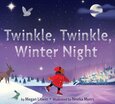 Review by Kristi Mahoney In Twinkle, Twinkle, Winter Night (September 20, 2022, Clarion books), debut author, Megan Litwin and illustrator Nneka Myers take readers on an exquisite journey through a magnificent winter wonderland. Using the beloved nursery rhyme, this story presents a winter romp that explores all the diverse ways animals and people experience and celebrate the winter months. Every page is a new discovery of light —from serene, snow-draped landscapes sprinkled with woodland creatures, to family-fun on a shimmery pond, to a bustling town come alive with the many celebrations of the season. Nneka Myer’s beautiful illustrations add another layer to this story, creating a world filled with whimsical characters, joyous details, and scenes that glow with every turn of the page. Twinkle, Twinkle, Winter Night is a beautiful book about finding joy in the details, seeing light in the darkness, and discovering all of the many wonders of the season. The exploration of winter activities makes it an ideal classroom companion, while the snuggle-in mood of the book equally lends it to bedtime reading. So, grab a steaming cup of cocoa, pile it high with marshmallows, and drink in this cozy winter wonderland. Twinkle, Twinkle, Winter Night is sure to shine bright throughout the entire season and for years to come. On Writing: With a fresh twist on the familiar classic of Twinkle, Twinkle, Little Star, Megan ensures that every rhyme sings and every word sparkles. Why say “stars” when you can say, the “sky sparkles like a chandelier”? Simple candles illuminate when they become “windows wink with eyes of gold.” Megan shows us that well-chosen words are magical, transforming a manuscript into a work of art. Megan’s tale also includes a diverse mix of events, honoring many different observances to warm the hearts of readers from various backgrounds. Below is a summary of ways you could use Twinkle, Twinkle, Winter Night, as a mentor text for your own manuscript:
To learn more about Megan, visit https://www.meganlitwinbooks.com/ Browse Nneka's fabulous portfolio at https://www.nnekamyers.com/ Click here for vendor links. 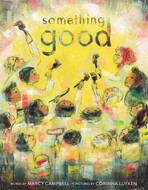 Review by Megan Litwin The first page of SOMETHING GOOD (LBYR, 2021) written by Marcy Campbell, illustrated by Corinna Luyken, starts like this: “The day the custodian found the bad-something on the bathroom wall…” With those words, Campbell drops us right into this beautiful, powerful story – and into the tangle of feelings and questions that circle through an entire school community. As readers, we never find out exactly what was written on the wall. But the students do (as kids always do) - and everything changes. In the aftermath we see varied emotions, as children and adults process those emotions in different ways. Ultimately, the community finds a way to move forward and toward healing as they create “something good” together. There is so much to love about this book – from Campbell’s sensitive and careful approach to difficult subject matter to Luyken’s signature color-forward approach. Huge double-spreads on each page swirl with colors that evoke emotion. Everything feels immediate – the writing, the feelings, the faces. Much like ADRIAN SIMCOX DOES NOT HAVE A HORSE, another layered title by this same dream team, SOMETHING GOOD is a timeless picture book that can help build better humans. And that is something VERY good. On Writing:
Marcy Campbell is a strong writer, and she makes two conscious and powerful decisions here that make readers feel connected from the start. First, even though there is a singular narrator, that narrator (a girl) is a collective voice for the school. She uses encompassing plural pronouns like “we” and “us” and focuses on the things that are happening to and with the group. Consequently, the story becomes everyone’s story; everyone in the book – and everyone reading it, too. Second, note Campbell’s straightforward prose. There is no extra imagery or description just to be pretty – the beauty is in the direct language that allows WHAT is happening to take center stage. It leaves room for readers to feel all the things they need to feel. A lesson in “less is always more.” Use SOMETHING GOOD to consider the nouns you assign your manuscript's narrator and the power that gives your narrator and your story. Finally, be brave and follow the example of SOMETHING GOOD- cut the flowery language in your prose to allow the beauty of an underlying message to shine. Review by Annie Cronin Romano When writers are seeking mentor texts that depict subtle ways to convey a message, the standouts can be challenging to find. There are picture books galore with themes of kindness, understanding, and acceptance, but far fewer that convey those themes with a light touch that permits young readers to experience the sentiment as it's developed rather that have it stated to them. Two recent standouts in the area of nuanced, subtle storytelling are Blanca Gómez's DRESS-UP DAY (Abrams, 2022) and Mac Barnett's JOHN'S TURN (Candlewick 2022). 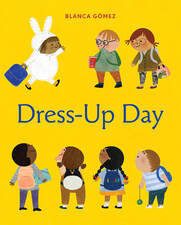 In DRESS-UP DAY, a young girl is distressed to have missed her opportunity to dress up as a bunny for her class' dress-up day because she's out sick. She decides to wear her bunny outfit to school the next day (What could go wrong?) only to find the stares and snickers of her classmates crush her excitement about her costumed appearance. When a fellow classmate shows up wearing his carrot costume, caring not a smidge if the others in the class approve or not, the two enjoy a day of imaginative play. And their peers? They decide maybe costumes and pretend play might be fine any day one chooses and shouldn't have to be relegated to an assigned date. This change of heart is shown (never told) when the other children come to school the next day with dress-up gear of their own. On Writing: With smart, sparse text and evocative illustrations that make the characters' emotions dance off the page, Gómez conveys a message of acceptance and kindness without once stating or summarizing the theme of her story. The actions and illustrations do the heavy lifting but leave the interpretation to the reader. 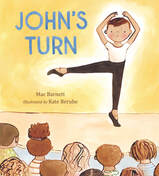 In JOHN'S TURN, it's a young boy's turn to demonstrate his talent during the school's "Sharing Gifts" time. While a few children comment on the unfamiliar music playing before John takes the stage and question what he's about to do, John musters up the courage to perform his ballet routine in front of his school with confidence and pride. The audience of children, after watching the feat of John's impressive dancing, applaud him for his impressive talent. On Writing: In JOHN'S TURN, Barnett never once mentions that ballet is often considered by many to be a female pursuit, nor does he state that the children may be dubious of John's choice of interest. Rather, he lets the children's reactions--from a few snickers to intrigued silence to impressed applause--show how John's talent and passion for ballet breaks down the boundaries of conventional--though outdated--gender norms. Barnett's simple yet strong text--along with expressive illustrations by Kate Berube--gives the reader the space to experience the emotional power of the story without once pointing out the message. Both DRESS-UP DAY and JOHN'S TURN are consummate examples of picture book texts that address themes of acceptance and kindness in a most subtle manner.  Review by Kelly Carey If you have ever been a substitute teacher and had to contend with a constant barrage of “that’s not the way we do it”, this lovable and laughable picture book is for you! The Creature of Habit (Random House Studio, 2021), by Jennifer E. Smith and illustrated by Leo Espinosa, tells the story of an island dwelling creature who loves his routine. He does everything the exact same way every day. When a surprise newcomer arrives the Creature of Habit shows him the daily schedule, but the newcomer breaks with the plan. The result is fun, silly, and charming for the reader but “absolute madness” for the Creature of Habit. With colorful and fanciful illustrations filled with pineapples and seashells this story is a tropical reminder that mixing things up every once in a while, can be amazing. On Writing:
If you are looking for a humorous comp title featuring a bit of wordplay, The Creature of Habit would be a fabulous choice. But don’t miss the opportunity to study Smith’s use of varied sentence structure. This is a great mentor text to examine the way long vs short, and serious vs silly sentences can move plot, create tension, drive pacing, and enhance readability. Smith also stays fully focused on her kid audience as she moves her characters through hysterical antics and keeps the mood light using pineapples, bananas, and fish. The result is a kid friendly story filled with giggly moments hiding a deeper message about breaking out of a routine and trying something new. Perhaps reading The Creature of Habit will help you find something new in your manuscripts. Learn more about Jennifer E. Smith here. And explore Leo Espinosa's portfolio here. |
Our favorite mentor texts to guide your writing and revisions.
Categories
All
Archives
April 2024
|
 RSS Feed
RSS Feed